Abstract
OBJECTIVE:
To identify global research trends of stem cell transplantation for treating Parkinson's disease using a bibliometric analysis of the Web of Science.
DATA RETRIEVAL:
We performed a bibliometric analysis of data retrievals for stem cell transplantation for treating Parkinson's disease from 2002 to 2011 using the Web of Science.
SELECTION CRITERIA:
Inclusion criteria: (a) peer-reviewed articles on stem cell transplantation for treating Parkinson's disease which were published and indexed in the Web of Science; (b) type of articles: original research articles, reviews, meeting abstracts, proceedings papers, book chapters, editorial material and news items; (c) year of publication: 2002–2011. Exclusion criteria: (a) articles that required manual searching or telephone access; (b) we excluded documents that were not published in the public domain; (c) we excluded a number of corrected papers from the total number of articles.
MAIN OUTCOME MEASURES:
(1) Type of literature; (2) annual publication output; (3) distribution according to journals; (4) distribution according to subject areas; (5) distribution according to country; (6) distribution according to institution; (7) comparison of countries that published the most papers on stem cell transplantation from different cell sources for treating Parkinson's disease; (8) comparison of institutions that published the most papers on stem cell transplantation from different cell sources for treating Parkinson's disease in the Web of Science from 2002 to 2011; (9) comparison of studies on stem cell transplantation from different cell sources for treating Parkinson's disease
RESULTS:
In total, 1 062 studies on stem cell transplantation for treating Parkinson's disease appeared in the Web of Science from 2002 to 2011, almost one third of which were from American authors and institutes. The number of studies on stem cell transplantation for treating Parkinson's disease had gradually increased over the past 10 years. Papers on stem cell transplantation for treating Parkinson's disease appeared in journals such as Stem Cells and Experimental Neurology. Although the United States published more articles addressing neural stem cell and embryonic stem cell transplantation for treating Parkinson's disease, China ranked first for articles published on bone marrow mesenchymal stem cell transplantation for treating Parkinson's disease.
CONCLUSION:
From our analysis of the literature and research trends, we found that stem cell transplantation for treating Parkinson's disease may offer further benefits in regenerative medicine.
Keywords: Parkinson's disease, neural stem cells, embryonic stem cells, bone marrow mesenchymal stem cells, cell transplantation, bibliometric analysis, Web of Science, neural regeneration
Abbreviations:
PD, Parkinson's disease
INTRODUCTION
Parkinson's disease (PD) is a slow-onset neurodegenerative disorder, with selective loss of substantia nigral dopaminergic neurons and significant reduction of striatal dopamine content. The incidence rate of PD rises with age to about 1% in the population of 65 years of age or older[1]. PD is caused by a decrease in the level of dopamine in the striatum due to degeneration of dopaminergic neurons. At present, drug treatments and surgery cannot fundamentally solve the problem. With the development of cell replacement therapy, medical professionals are exploring treatment by restoration of dopamine neurotransmitters in the neural circuitry of patients with PD by getting dopaminergic neurons and cell transplantation. In 1988, Lindvall et al[2] first used human embryonic midbrain transplantation for the treatment of idiopathic PD. Later, Freed et al[3] transplanted human embryonic midbrain dopaminergic cells into the brains of Parkinson's patients, which substantially alleviated the clinical symptoms. The pathogenesis of PD is clear, the anatomical localization of the nucleus related to pathogenesis is explicit, animal models have been established, and the results of some clinical trials are favorable. Therefore, PD is regarded as one of the most treatable diseases by stem cell transplantation[4]. Transplanted stem cells can infiltrate and integrate with diseased tissue, differentiate into dopaminergic neurons to replace damaged cells and reconstruct neuronal circuits to restore nerve function. Commonly used stem cells to treat PD are neural stem cells, embryonic stem cells and bone marrow mesenchymal stem cells. Reynolds and Weiss[5] proposed the concept of neural stem cells. However, the generally accepted concept was proposed by Mckay in 1997[6]. The concept is that neural stem cells have the ability to differentiate into neurons, astrocytes and oligodendrocytes, they can self-renew and generate a large number of neural cell types. Results of induced differentiation in vitro show that different conditions can induce neural stem cells to differentiate into different types of neurons, astrocytes and oligodendrocytes. In addition, differentiated neurons have different phenotypes to perform different functions with neurotransmitters. Therefore, neural stem cell transplantation can have an effect on the pathological process of PD. There was a landmark study of embryonic stem cells to treat PD in 2005. Takagi et al[7] carried out directed induced differentiation of rhesus monkey embryonic stem cells, prepared donor cells that were very similar to endogenous dopaminergic neurons, and transplanted them into a monkey model of PD induced by 1-methyl-4-phenyl-tetrahydropyridine. After transplantation, positron emission tomography showed that living transplanted cells were able to exert the function of dopaminergic neurons, and significantly improved behavioral symptoms of the monkey model of PD. The 1-methyl-4-phenyl-tetrahydropyridine-induced PD model is very similar to PD in humans, and the experimental results predict the efficacy of clinical application of cell transplantation accurately[8]. Experimental results in vitro show that after induced differentiation by a specific inducer, adult mouse and human mesenchymal stem cells gradually show the morphological characteristics of neurons and express specific markers of neurons such as neuron-specific enolase[9]. This observation confirms that mesenchymal stem cells can be induced to differentiate into nerve cells in vitro by nerve growth factor and brain-derived nerve growth factor[10].
Our study is designed to compare different cell sources for stem cell transplantation for treating PD from published research papers found on the Web of Science from 2002 to 2011.
DATA SOURCES AND METHODOLOGY
Data retrieval
In this study, we used bibliometric methods to quantitatively and qualitatively investigate research trends in studies of stem cell transplantation for treating PD. For this purpose, we employed the Web of Science, a research database of publications and citations that are selected and evaluated by the Institute for Scientific Information in Philadelphia, PA, USA, using the key words “PD” “neural stem cells” “embryonic stem cells” “bone marrow mesenchymal stem cells” and “cell transplantation”. We limited the period of publication from 2002 to 2011 and searched 1 062 results, and downloaded the data on March 20, 2012.
Inclusion criteria
The inclusion criteria were as follows: (1) peer-reviewed articles on stem cell transplantation for treating PD which were published and indexed in the Web of Science, including original research articles, reviews, meeting abstracts, proceedings papers, book chapters, editorial material, and news items; (2) the year of publication was 2002–2011; (3) the citation database was Science Citation Index-Expanded (SCI-E).
Exclusion criteria
We excluded articles that required manual searching or telephone access. We excluded documents that were not published in the public domain. We excluded a number of corrected papers from the total number of articles analyzed.
The outcomes of all articles referring to stem cell transplantation for treating PD were measured using the following criteria: (a) type of literature on stem cell transplantation for treating PD; (b) annual publication output on stem cell transplantation for treating PD; (c) journal publications on stem cell transplantation for treating PD; (d) distribution of subject areas on stem cell transplantation for treating PD by subject area; (e) publications on stem cell transplantation for treating PD according to country; (f) publications on stem cell transplantation for treating PD by institution; (g) comparison of countries that published the most papers on stem cell transplantation from different cell sources for treating PD; (h) comparison of institutions that published the most papers on stem cell transplantation from different cell sources for treating PD; (i) comparison of study results on stem cell transplantation from different cell sources for treating PD.
RESULTS
The search results of stem cell transplantation from different cell sources for treating PD from 2002 to 2011 are presented in Table 1.
Table 1.
Number of publications on stem cell transplantation from different sources for treating Parkinson's disease from 2002 to 2011
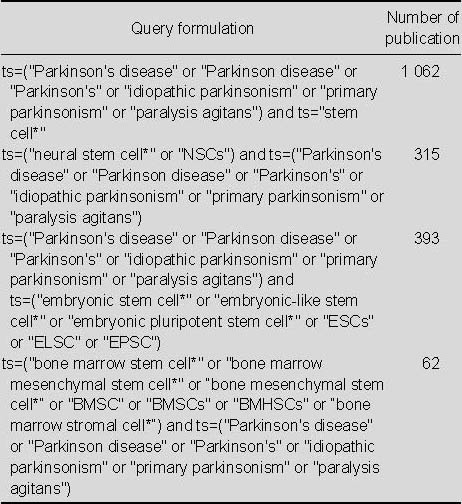
The different types of publications relating to stem cell transplantation for treating PD from 2002 to 2011 are presented in Table 2.
Table 2.
Types of publication on stem cell transplantation for treating Parkinson's disease included in the Web of Science from 2002 to 2011
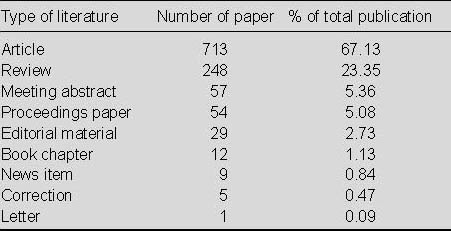
In Table 2, it is evident that articles, reviews, and meeting abstracts constituted the major types of publications related to stem cell transplantation for treating PD over this period. There were 713 articles accounting for 67.13% of the total number of publications, which was more than any other type of literature, followed by reviews (248) that accounted for 23.35%.
The annual publication output on stem cell transplantation for treating PD from 2002 to 2011 is presented in Figure 1.
Figure 1.
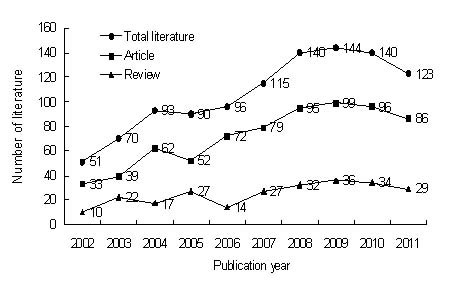
Annual number of publications on stem cell transplantation for treating Parkinson's disease in the Web of Science from 2002 to 2011.
There were 1 062 publications on stem cell transplantation for treating PD in the Web of Science from 2002 to 2011. The number of publications on stem cell transplantation for treating PD had gradually increased over the past 10 years. In total, 123 papers were published and included in the Web of Science in 2010, which was much more than that in 2002. However, there was a decrease in the number of papers published in 2005 and 2006.
The top 10 journals that published papers on stem cell transplantation for treating PD from 2002 to 2011 are presented in Table 3.
Table 3.
Top 10 journals that published studies on stem cell transplantation for treating Parkinson's disease included in the Web of Science from 2002 to 2011
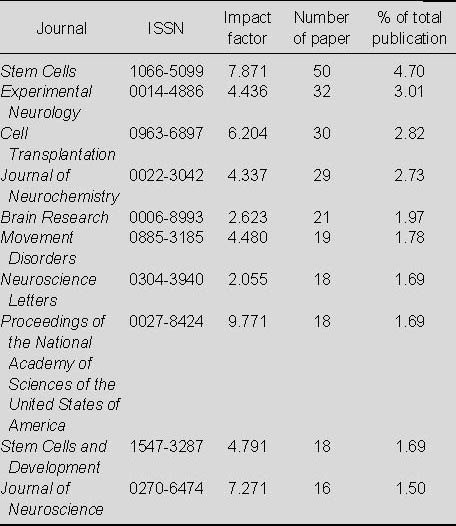
In Table 3, it is evident that most papers on stem cell transplantation for treating PD appeared in journals with a particular focus on neuroscience and stem cell research. Stem Cells published 50 papers that accounted for 4.70% of the total number of publications, followed by Experimental Neurology that published 32 papers and accounted for 3.01%.
The distribution of subject areas related to stem cell transplantation for treating PD from 2002 to 2011 is presented in Table 4.
Table 4.
Distribution of subject areas related to stem cell transplantation for treating Parkinson's disease included in the Web of Science from 2002 to 2011
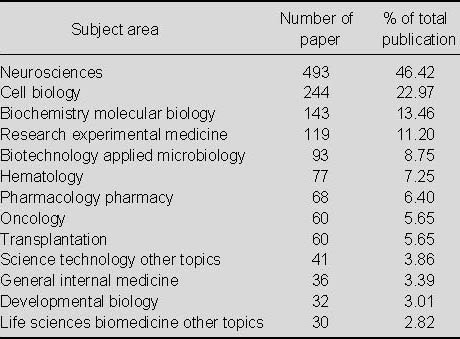
In Table 4, it is evident that among the subject categories related to stem cell transplantation for treating PD, the greatest number of studies (493 papers) was in the field of neuroscience, which accounted for 46.42%. With 244 papers, the second highest number of studies was in the field of cell biology, which accounted for 22.97%.
The country distribution of publications on stem cell transplantation for treating PD from 2002 to 2011 according to the country is presented in Table 5.
Table 5.
Top 10 countries in terms of number of studies on stem cell transplantation for treating Parkinson's disease included in the Web of Science from 2002 to 2011
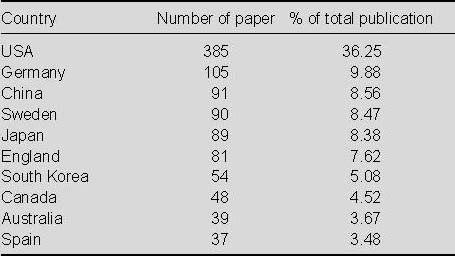
In Table 5, it is clear that the United States published the highest number of papers on stem cell transplantation for treating PD. The United States published 385 papers that accounted for 36.25% of the total, which is much higher than the number of papers published by other countries. Germany ranked second with 105 papers and accounted for 9.88%.
The number of publications on stem cell transplantation for treating PD from 2002 to 2011 according to the institution in presented in Table 6.
Table 6.
Top 14 institutions publishing studies on stem cell transplantation for treating Parkinson's disease in the Web of Science from 2002 to 2011
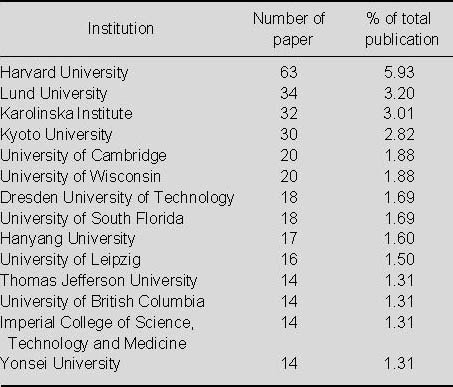
In Table 6, it is evident that the top institution for studies on stem cell transplantation for treating PD is Harvard University, followed by Lund University and the Karolinska Institute.
The comparison of countries and institutions that published the most papers on stem cell transplantation from different cell sources for treating PD from 2002 to 2011 is shown in Tables 7 and 8.
Table 7.
Comparison of countries that published most papers on transplantation of stem cells from different sources for treating Parkinson's disease in the Web of Science from 2002 to 2011

Table 8.
Comparison of institutions that published most papers on transplantation of stem cells from different sources for treating Parkinson's disease in the Web of Science from 2002 to 2011
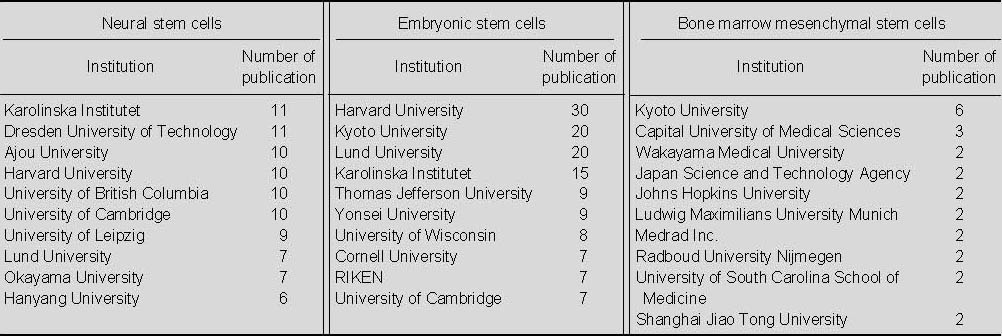
The analysis of articles on neural stem cell transplantation for treating PD from 2002 to 2011 is shown in Tables 9 and 10.
Table 9.
Most cited articles on neural stem cell transplantation for treating Parkinson's disease in the Web of Science from 2002 to 2011

Table 10.
Studies on neural stem cell transplantation for treating Parkinson's disease
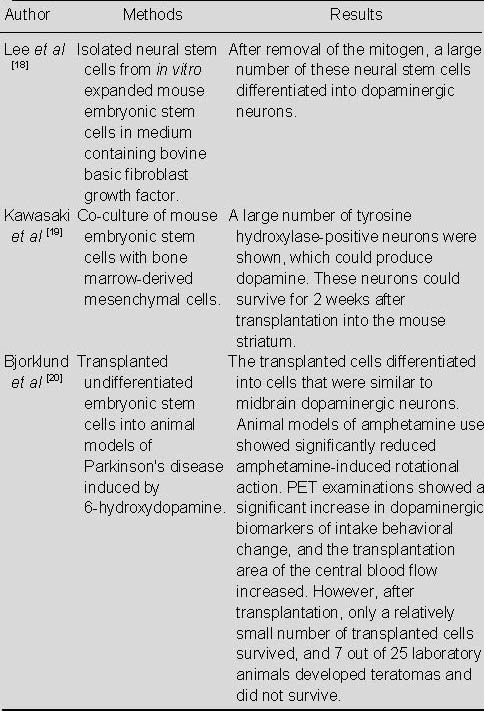
The analysis of articles on embryonic stem cell transplantation for treating PD from 2002 to 2011 is shown in Tables 11 and 12.
Table 11.
Most cited articles on embryonic stem cell transplantation for treating Parkinson's disease in the Web of Science from 2002 to 2011
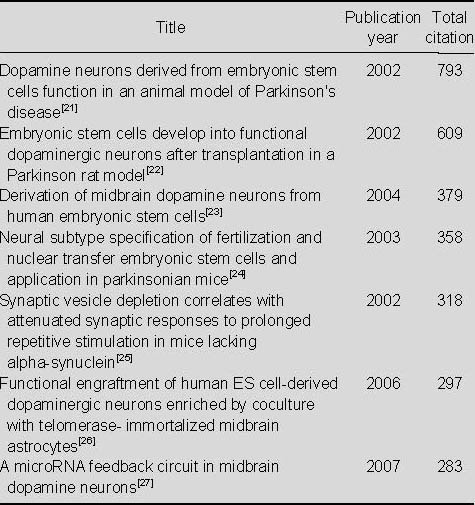
Table 12.
Studies on embryonic stem cell transplantation for treating Parkinson's disease
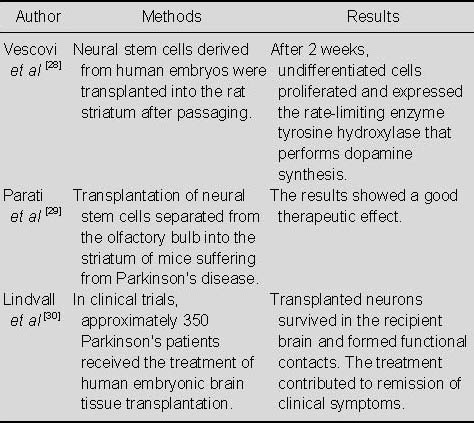
The analysis of articles on bone marrow mesenchymal stem cell transplantation for treating PD from 2002 to 2011 is shown in Tables 13 and 14.
Table 13.
Most cited articles on bone marrow mesenchymal stem cell transplantation for treating Parkinson's disease in the Web of Science from 2002 to 2011
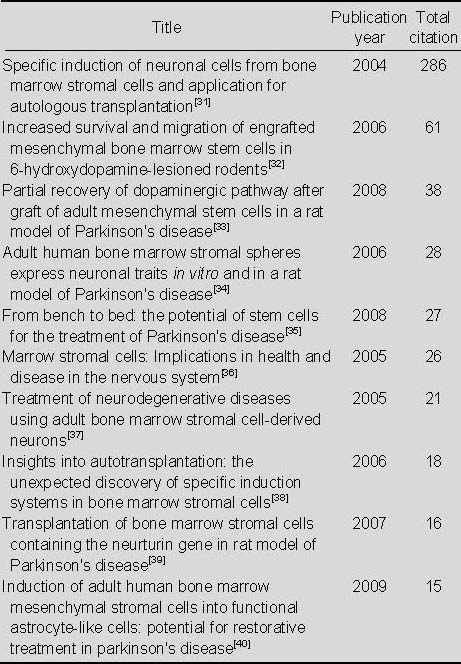
Table 14.
Studies on bone marrow mesenchymal stem cell transplantation for treating Parkinson's disease

DISCUSSION
Based on the bibliometric analysis, the following comparisons and results were obtained regarding stem cell transplantation for treating PD.
First, there are 1 062 research articles addressing stem cell transplantation for treating PD included in the Web of Science from 2002 to 2011. The research on stem cell transplantation for treating PD is attracting ever-increasing attention among global researchers from 2002, notwithstanding slight drops in outputs in 2005 and 2011.
Second, subject categories including neuroscience and cell biology are involved in stem cell transplantation for treating PD. Because of this broad range, scholars and surgeons in these areas work hard and readily publish articles on stem cell transplantation for treating PD.
Third, journals focusing on neuroscience published the most articles concerning stem cell transplantation for treating PD, and Stem Cells has the highest total number of publications.
The most cited paper is not necessarily the highest impact paper on an annual basis. The immediate impact during the year when they were published is indicated by the average citation per annum or the citation during each year.
Much attention and effort has been devoted to stroke treatment and rehabilitation using stem cell transplantation. The findings of the present study may be of interest to fellow researchers who are currently undertaking studies on stem cell transplantation for treating PD or those who may do so in the future.
Footnotes
Conflicts of interest: None declared.
(Edited by Zhao LJ/Song LP)
REFERENCES
- [1].Siderowf A, Stern M. Update to Parkinson disease. Ann Inter Med. 2003;138(8):651–658. doi: 10.7326/0003-4819-138-8-200304150-00013. [DOI] [PubMed] [Google Scholar]
- [2].Lindvall O, Rehncrona S, Gustuvii B, et al. Fetal dopamine-rich mesencephalic grafts in parkinson's disease. Lancet. 1988;2(8626-8627):1483–1484. doi: 10.1016/s0140-6736(88)90950-6. [DOI] [PubMed] [Google Scholar]
- [3].Freed CR, Greene PE, Breeze RE, et al. Transplantation of embryonic dopamine neurons for severe Parkinson's disease. N Engl J Med. 2001;344(10):710–719. doi: 10.1056/NEJM200103083441002. [DOI] [PubMed] [Google Scholar]
- [4].Bjorklund A, Lindvall O. Cell replacement therapies for central nervous system disorders. Nat Neurosci. 2003;3(6):537–544. doi: 10.1038/75705. [DOI] [PubMed] [Google Scholar]
- [5].Reynolds BA, Weiss S. Generation of neurons and astrocytes from isolated cells of the adult mammalian central nervous system. Science. 1992;255(5052):1707–1710. doi: 10.1126/science.1553558. [DOI] [PubMed] [Google Scholar]
- [6].Mckay R. Stem cells in the central nervous system. Science. 1997;276:66–71. doi: 10.1126/science.276.5309.66. [DOI] [PubMed] [Google Scholar]
- [7].Takagi Y, Takahashi J, Saiki H, et al. Dopaminergic neurons generated from monkey embryonic stem cells function in a Parkinson primate model. J Clin Invest. 2005;115(1):102–109. doi: 10.1172/JCI21137. [DOI] [PMC free article] [PubMed] [Google Scholar]
- [8].Langston JW. The promise of stem cells in Parkinson disease. J Clin Inves. 2005;115(1):23–25. doi: 10.1172/JCI24012. [DOI] [PMC free article] [PubMed] [Google Scholar]
- [9].Woodbury D, Schwarz EJ, Prockop DJ, et al. Adult rat and human bone marrow stromal cells differentiate into neurons. J Neurosci Res. 2000;61(4):364–370. doi: 10.1002/1097-4547(20000815)61:4<364::AID-JNR2>3.0.CO;2-C. [DOI] [PubMed] [Google Scholar]
- [10].Sanchez-Ramos J, Song S, Cardozo-Pelaez F, et al. Adult bone marrow stromal cells differentiate into neural cells in vitro. Exp Neurol. 2000;164(2):247–256. doi: 10.1006/exnr.2000.7389. [DOI] [PubMed] [Google Scholar]
- [11].Zhao C, Deng W, Gage FH. Mechanisms and functional implications of adult neurogenesis. Cell. 2008;132(4):645–660. doi: 10.1016/j.cell.2008.01.033. [DOI] [PubMed] [Google Scholar]
- [12].Zhao M, Momma S, Delfani K, et al. Evidence for neurogenesis in the adult mammalian substantia nigra. Proc Natl Acad Sci U S A. 2003;100(13):7925–7930. doi: 10.1073/pnas.1131955100. [DOI] [PMC free article] [PubMed] [Google Scholar]
- [13].Höglinger GU, Rizk P, Muriel MP, et al. Dopamine depletion impairs precursor cell proliferation in Parkinson disease. Nat Neurosci. 2004;7(7):726–735. doi: 10.1038/nn1265. [DOI] [PubMed] [Google Scholar]
- [14].Lie DC, Dziewczapolski G, Willhoite AR, et al. The adult substantia nigra contains progenitor cells with neurogenic potential. J Neurosci. 2002;22(15):6639–6649. doi: 10.1523/JNEUROSCI.22-15-06639.2002. [DOI] [PMC free article] [PubMed] [Google Scholar]
- [15].Mattson MP, Chan SL, Duan W. Modification of brain aging and neurodegenerative disorders by genes, diet, and behavior. Physiol Rev. 2002;82(3):637–672. doi: 10.1152/physrev.00004.2002. [DOI] [PubMed] [Google Scholar]
- [16].Goldman S. Stem and progenitor cell-based therapy of the human central nervous system. Nat Biotechnol. 2005;23(7):862–871. doi: 10.1038/nbt1119. [DOI] [PubMed] [Google Scholar]
- [17].Frielingsdorf H, Schwarz K, Brundin P, et al. No evidence for new dopaminergic neurons in the adult mammalian substantia nigra. Proc Natl Acad Sci U S A. 2004;101(27):10177–10182. doi: 10.1073/pnas.0401229101. [DOI] [PMC free article] [PubMed] [Google Scholar]
- [18].Lee SA, Lumelsky N, Studer L, et al. Efficient generation of midbrain and hindbrain neurons from mouse embryonic stem cells. Nat Biotechnol. 2000;18(6):675–679. doi: 10.1038/76536. [DOI] [PubMed] [Google Scholar]
- [19].Kawasaki H, Mizuseki K, Nishikawa S, et al. Induction of midbrain dopaminergic neurons from ES cells by stromal cell-derived inducing activity. Neuron. 2000;28(1):31–40. doi: 10.1016/s0896-6273(00)00083-0. [DOI] [PubMed] [Google Scholar]
- [20].Bjorklund LM, Sanchez-Pernaute R, Chung S, et al. Embryonic stem cells develop into functional dopaminergic neurons after transplantation in a Parkinson rat model. Proc Natl Acad Sci U S A. 2002;99(4):2344–2349. doi: 10.1073/pnas.022438099. [DOI] [PMC free article] [PubMed] [Google Scholar]
- [21].Kim JH, Auerbach JM, Rodríguez-Gómez JA, et al. Dopamine neurons derived from embryonic stem cells function in an animal model of Parkinson's disease. Nature. 2002;418(6893):50–56. doi: 10.1038/nature00900. [DOI] [PubMed] [Google Scholar]
- [22].Bjorklund LM, Sánchez-Pernaute R, Chung S, et al. Embryonic stem cells develop into functional dopaminergic neurons after transplantation in a Parkinson rat model. Proc Natl Acad Sci U S A. 2002;99(4):2344–2349. doi: 10.1073/pnas.022438099. [DOI] [PMC free article] [PubMed] [Google Scholar]
- [23].Perrier AL, Tabar V, Barberi T, et al. Derivation of midbrain dopamine neurons from human embryonic stem cells. Proc Natl Acad Sci U S A. 2004;101(34):12543–12548. doi: 10.1073/pnas.0404700101. [DOI] [PMC free article] [PubMed] [Google Scholar]
- [24].Barberi T, Klivenyi P, Calingasan NY, et al. Neural subtype specification of fertilization and nuclear transfer embryonic stem cells and application in parkinsonian mice. Nat Biotechnol. 2003;21(10):1200–1207. doi: 10.1038/nbt870. [DOI] [PubMed] [Google Scholar]
- [25].Cabin DE, Shimazu K, Murphy D, et al. Synaptic vesicle depletion correlates with attenuated synaptic responses to prolonged repetitive stimulation in mice lacking alpha-synuclein. J Neurosci. 2002;22(20):8797–8807. doi: 10.1523/JNEUROSCI.22-20-08797.2002. [DOI] [PMC free article] [PubMed] [Google Scholar]
- [26].Roy NS, Cleren C, Singh SK, et al. Functional engraftment of human ES cell-derived dopaminergic neurons enriched by coculture with telomerase- immortalized midbrain astrocytes. Nat Med. 2006;12(11):1259–1268. doi: 10.1038/nm1495. [DOI] [PubMed] [Google Scholar]
- [27].Kim J, Inoue K, Ishii J, et al. A microRNA feedback circuit in midbrain dopamine neurons. Science. 2007;317(5842):1220–1224. doi: 10.1126/science.1140481. [DOI] [PMC free article] [PubMed] [Google Scholar]
- [28].Vescovi AL, Parati EA, Gritti A, et al. Isolation and cloning of multipotential stem cells from the embryonic human CNS and establishment of transplantable human neural stem cell lines by epigenetic stimulation. Exp Neurol. 1999;156(1):71–83. doi: 10.1006/exnr.1998.6998. [DOI] [PubMed] [Google Scholar]
- [29].Parati EA, Bez A, Ponti D, et al. Neural stem cells. Biological features and therapeutic potential in Parkinson's disease. J Neurosurg Sci. 2003;47(1):8–17. [PubMed] [Google Scholar]
- [30].Lindball O, Hagell P. Cell replacement therapy in human neurodegenerative disorders. Clini Neurosci Res. 2002;2:86–92. [Google Scholar]
- [31].Dezawa M, Kanno H, Hoshino M, et al. Specific induction of neuronal cells from bone marrow stromal cells and application for autologous transplantation. J Clin Invest. 2004;113(12):1701–1710. doi: 10.1172/JCI20935. [DOI] [PMC free article] [PubMed] [Google Scholar]
- [32].Hellmann MA, Panet H, Barhum Y, et al. Increased survival and migration of engrafted mesenchymal bone marrow stem cells in 6-hydroxydopamine-lesioned rodents. Neurosci Lett. 2006;395(2):124–128. doi: 10.1016/j.neulet.2005.10.097. [DOI] [PubMed] [Google Scholar]
- [33].Bouchez G, Sensebé L, Vourc’h P, et al. Partial recovery of dopaminergic pathway after graft of adult mesenchymal stem cells in a rat model of Parkinson's disease. Neurochem Int. 2008;52(7):1332–1342. doi: 10.1016/j.neuint.2008.02.003. [DOI] [PubMed] [Google Scholar]
- [34].Suon S, Yang M, Iacovitti L. Adult human bone marrow stromal spheres express neuronal traits in vitro and in a rat model of Parkinson's disease. Brain Res. 2006;1106(1):46–51. doi: 10.1016/j.brainres.2006.05.109. [DOI] [PMC free article] [PubMed] [Google Scholar]
- [35].Morizane A, Li JY, Brundin P. From bench to bed: the potential of stem cells for the treatment of Parkinson's disease. Cell Tissue Res. 2008;331(1):323–336. doi: 10.1007/s00441-007-0541-0. [DOI] [PubMed] [Google Scholar]
- [36].Dezawa M, Hoshino M, Nabeshima Y, et al. Marrow stromal cells: Implications in health and disease in the nervous system. Curr Mol Med. 2005;5(7):723–732. doi: 10.2174/156652405774641070. [DOI] [PubMed] [Google Scholar]
- [37].Dezawa M, Hoshino M, Ide C. Treatment of neurodegenerative diseases using adult bone marrow stromal cell-derived neurons. Expert Opin Biol Ther. 2005;5(4):427–435. doi: 10.1517/14712598.5.4.427. [DOI] [PubMed] [Google Scholar]
- [38].Dezawa M. Insights into autotransplantation: the unexpected discovery of specific induction systems in bone marrow stromal cells. Cell Mol Life Sci. 2006;63(23):2764–2772. doi: 10.1007/s00018-006-6191-7. [DOI] [PMC free article] [PubMed] [Google Scholar]
- [39].Ye M, Wang XJ, Zhang YH, et al. Transplantation of bone marrow stromal cells containing the neurturin gene in rat model of Parkinson's disease. Brain Res. 2007;1142:206–216. doi: 10.1016/j.brainres.2006.12.061. [DOI] [PubMed] [Google Scholar]
- [40].Bahat-Stroomza M, Barhum Y, Levy YS, et al. Induction of adult human bone marrow mesenchymal stromal cells into functional astrocyte-like cells: potential for restorative treatment in Parkinson's disease. J Mol Neurosci. 2009;39(1-2):199–210. doi: 10.1007/s12031-008-9166-3. [DOI] [PubMed] [Google Scholar]
- [41].Yano S, Kuroda S, Lee JB, et al. In vivo fluorescence tracking of bone marrow stromal cells transplanted into a pneumatic injury model of rat spinal cord. J Neurotrauma. 2005;22(8):907–918. doi: 10.1089/neu.2005.22.907. [DOI] [PubMed] [Google Scholar]
- [42].Li Y, Chen J, Wang L, et al. Intracerebral transplantation of bone marrow stromal cells in a 1-methyl-4-phenyl-1,2,3, 6-tetrahydropyridine mouse model of Parkinson's disease. Neurosci Lett. 2001;316(2):67–70. doi: 10.1016/s0304-3940(01)02384-9. [DOI] [PubMed] [Google Scholar]


